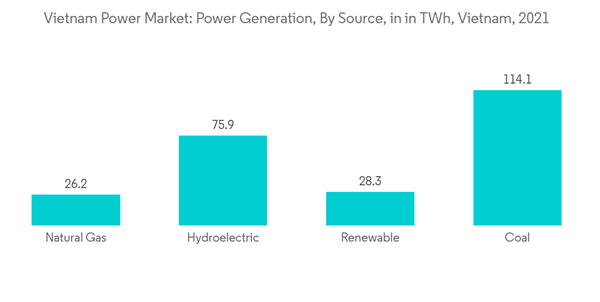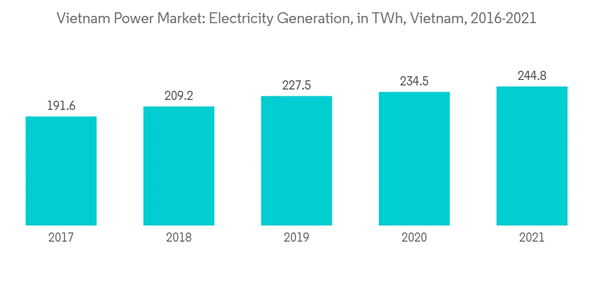The market was negatively impacted by COVID-19 in 2020. Presently the market has now reached pre-pandemic levels.
Key Highlights
- Over the medium term, in Vietnam, the power market is undergoing significant transformation owing to the efforts taken by the government to improve electricity access in the country, along with its plans to increase the share of renewables in the country's power generation mix, these factors aid in driving the market growth.
- On the other hand, huge investments are required to set up and modernize power generation, transmission, or distribution networks, and weak private sector investments are restraining the power market in Vietnam.
- Nevertheless, Vietnam has some of the most significant wind resources, creating enormous opportunities to exploit wind energy for power generation. The factors above clubbed with foreign investment and extensive R&D projects, offer an opportunity to grow the power market in Vietnam.
Vietnam Power Market Trends
Thermal Power Generation Sector to Dominate the Market
- Power generation uses a variety of sources ranging from fossil fuels like coal and oil to renewable sources like wind and solar. The country's energy mix for electricity generation is dominated by fossil fuels like coal, oil, and natural gas, constituting almost 65% of the global energy mix.
- In 2021, more than 46% of electricity in Vietnam was generated through coal power sources, with 114.1 TWh of power generation. Natural gas will account for around 11% of the energy mix in 2021.
- The power generation mix is heavily skewed toward coal, with a significant contribution because of cheaper domestic fuel availability. Its share in the mix has increased due to constraints in adding other conventional generation sources like hydro, nuclear, and natural gas.
- Further, Vietnam is dependent on coal power plants, and in the past decade, the country heavily invested in coal power plants to meet the country's power demand. In February 2021, the Ministry of Industry and Trade of Vietnam (MOIT) released the national power development plan 9 (PDP8), where the country plans to add 37 gigawatts of coal-fired power plants by 2030.
- As of 2022, the Quang Trach 1 Coal-fired Power Plant is under construction in Vietnam with a capacity of 1.2 gigawatts, and the estimated plant investment is USD 1.2 billion. The project is expected to be commissioned by 2025 and generate up to 8.4 billion kilowatt-hours of electricity annually.
- Owing to these factors, thermal power generation is expected to dominate the market studied during the forecast period.
Government Initiatives Expected to Drive the Market
- Government policies and support for electricity generation and the increase in investments in electricity transmission are expected to drive the Vietnamese power market during the forecast period.
- Vietnam has adequate power generation capacity, but some proportion of the population has limited access to electricity because of a lack of proper grid network and infrastructure. To ensure the supply of reliable electricity for all, the demand for transmission networks is growing. Thus, investments have been made to increase the transmission network in Vietnam.
- As per Vietnam's Eighth Electricity Plan Draft, it is estimated that during the 2021-2030 period, Vietnam needs to build additional 500 kV substations with a total capacity of 86 GVA and approximately 13,000 kilometers of transmission lines.
- Additionally, According to Power Development Plan 8, Vietnam's electricity capacity is expected to increase by an annual average of 5.7% between 2021 and 2030, reaching 129.5 GW by 2030. Also, USD 148 billion worth of investments are planned to increase power generation and develop the electricity network, of which 74% will be directed to power sources and 26% to grid development for 2021-2030.
- In recent years, the Vietnamese government has also funded various transmission projects to ensure a reliable electricity supply in multiple locations. Vietnam’s Ministry of Industry and Trade (MOIT), under its draft PDP8, estimated the need for USD 32.9 billion to develop its power grids between 2021-2030. The plan proposes expanding a 500 kV transmission system to transmit power from power source centers in the central and southern regions to larger load centers in the Red River Delta and Ho Chi Minh City.
- In 2021, Vietnam generated 244.8 Terawatt-hours (TWh) of electricity, up from 175.7 Terawatt-hours (TWh) in 2016. The power generation capacity is expected to increase from conventional and renewable sources over the coming years. The country has made significant strides in improving access to power among communes and rural communities through various government-led schemes.
- In addition, the country is focusing on renewable energy in order to achieve net zero carbon emission and reduce reliance on coal imports, and under the PDP8 the country plans to construct 19-20 gigawatt of solar energy and 18-19 gigawatt of wind energy. For example, in 2022, Vietnam’s government authorities approved the construction of two floating solar projects on the Khe Go and Vuc Mau lakes with a total capacity of 450 MW. Both are expected to be commissioned by the end of December 2023 and is estimated to cost USD 340 billion.
- Therefore, government support and policies to ensure power distribution and allocation of investments to develop transmission lines and towers to cater to consumers are expected to drive the power market in Vietnam during the forecast period.
Vietnam Power Industry Overview
The Vietnamese power market is moderately consolidated. Some key players in this market (not in particular order) include Vietnam Electricity, Jera Co. Inc., AES Mong Duong Power Company Limited, General Electric, and Mekong Energy Company Ltd, among others.Additional Benefits:
- The market estimate (ME) sheet in Excel format
- 3 months of analyst support
This product will be delivered within 2 business days.
Table of Contents
Companies Mentioned (Partial List)
A selection of companies mentioned in this report includes, but is not limited to:
- Vietnam Electricity
- Jera Co. Inc.
- AES Mong Duong Power Company Limited
- General Electric
- Mekong Energy Company Ltd
- Vietnam Sunergy Joint Stock Company
- Sharp Energy Solutions Corporation










